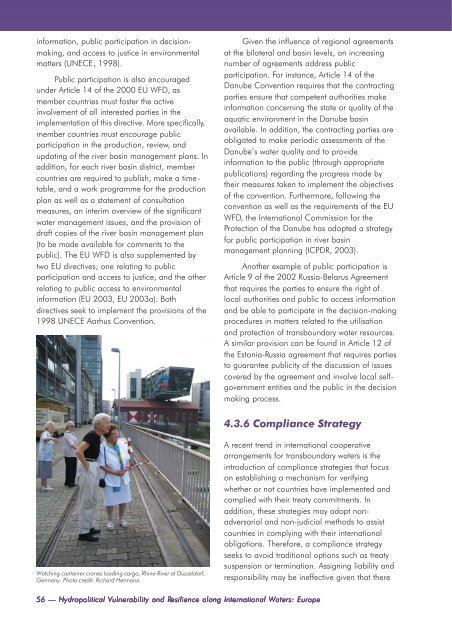Europe - UNEP
Europe - UNEP
Europe - UNEP
You also want an ePaper? Increase the reach of your titles
YUMPU automatically turns print PDFs into web optimized ePapers that Google loves.
information, public participation in decisionmaking,<br />
and access to justice in environmental<br />
matters (UNECE, 1998).<br />
Public participation is also encouraged<br />
under Article 14 of the 2000 EU WFD, as<br />
member countries must foster the active<br />
involvement of all interested parties in the<br />
implementation of this directive. More specifically,<br />
member countries must encourage public<br />
participation in the production, review, and<br />
updating of the river basin management plans. In<br />
addition, for each river basin district, member<br />
countries are required to publish, make a timetable,<br />
and a work programme for the production<br />
plan as well as a statement of consultation<br />
measures, an interim overview of the significant<br />
water management issues, and the provision of<br />
draft copies of the river basin management plan<br />
(to be made available for comments to the<br />
public). The EU WFD is also supplemented by<br />
two EU directives; one relating to public<br />
participation and access to justice, and the other<br />
relating to public access to environmental<br />
information (EU 2003, EU 2003a). Both<br />
directives seek to implement the provisions of the<br />
1998 UNECE Aarhus Convention.<br />
Given the influence of regional agreements<br />
at the bilateral and basin levels, an increasing<br />
number of agreements address public<br />
participation. For instance, Article 14 of the<br />
Danube Convention requires that the contracting<br />
parties ensure that competent authorities make<br />
information concerning the state or quality of the<br />
aquatic environment in the Danube basin<br />
available. In addition, the contracting parties are<br />
obligated to make periodic assessments of the<br />
Danube’s water quality and to provide<br />
information to the public (through appropriate<br />
publications) regarding the progress made by<br />
their measures taken to implement the objectives<br />
of the convention. Furthermore, following the<br />
convention as well as the requirements of the EU<br />
WFD, the International Commission for the<br />
Protection of the Danube has adopted a strategy<br />
for public participation in river basin<br />
management planning (ICPDR, 2003).<br />
Another example of public participation is<br />
Article 9 of the 2002 Russia-Belarus Agreement<br />
that requires the parties to ensure the right of<br />
local authorities and public to access information<br />
and be able to participate in the decision-making<br />
procedures in matters related to the utilisation<br />
and protection of transboundary water resources.<br />
A similar provision can be found in Article 12 of<br />
the Estonia-Russia agreement that requires parties<br />
to guarantee publicity of the discussion of issues<br />
covered by the agreement and involve local selfgovernment<br />
entities and the public in the decision<br />
making process.<br />
4.3.6 Compliance Strategy<br />
Watching container cranes loading cargo, Rhine River at Dusseldorf,<br />
Germany. Photo credit: Richard Hermann.<br />
A recent trend in international cooperative<br />
arrangements for transboundary waters is the<br />
introduction of compliance strategies that focus<br />
on establishing a mechanism for verifying<br />
whether or not countries have implemented and<br />
complied with their treaty commitments. In<br />
addition, these strategies may adopt nonadversarial<br />
and non-judicial methods to assist<br />
countries in complying with their international<br />
obligations. Therefore, a compliance strategy<br />
seeks to avoid traditional options such as treaty<br />
suspension or termination. Assigning liability and<br />
responsibility may be ineffective given that there<br />
56 — Hydropolitical Vulnerability and Resilience along International Waters: <strong>Europe</strong>
















